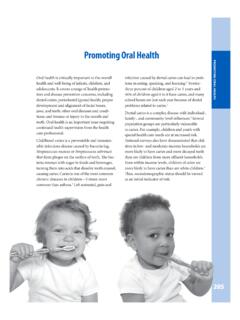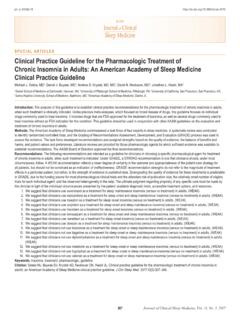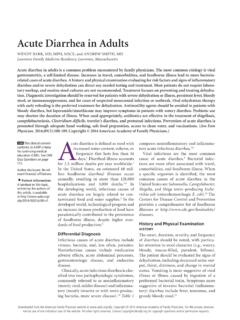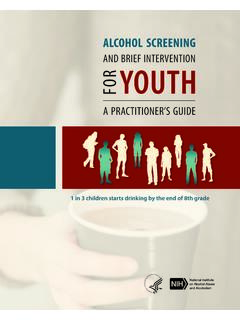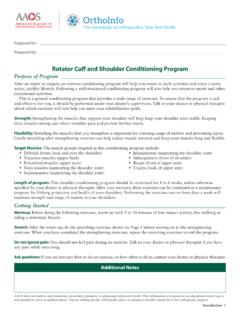Transcription of Mildly Elevated Liver Transaminase Levels: Causes and ...
1 December 1, 2017 Volume 96, Number 11 american family physician 709 Mild, asymptomatic elevations (less than five times the upper limit of normal) of alanine Transaminase and aspar-tate Transaminase levels are common in primary care. It is estimated that approximately 10% of the popula-tion has Elevated Transaminase levels. An approach based on the prevalence of diseases that cause asymptomatic Transaminase elevations can help clinicians efficiently identify common and serious Liver disease. The most com-mon Causes of Elevated Transaminase levels are nonalcoholic fatty Liver disease and alcoholic Liver disease. Uncom-mon Causes include drug-induced Liver injury, hepatitis B and C, and hereditary hemochromatosis. Rare Causes include alpha1-antitrypsin deficiency, autoimmune hepatitis, and Wilson disease. Extrahepatic sources, such as thyroid disorders, celiac sprue, hemolysis, and muscle disorders, are also associated with Mildly Elevated transami-nase levels.
2 The initial evaluation should include an assessment for metabolic syndrome and insulin resistance ( , waist circumference, blood pressure, fasting lipid level, and fasting glucose or A1C level); a complete blood count with platelets; measurement of serum albumin, iron, total iron-binding capacity, and ferritin; and hepatitis C anti-body and hepatitis B surface antigen testing. The nonalcoholic fatty Liver disease fibrosis score and the alcoholic Liver disease/nonalcoholic fatty Liver disease index can be helpful in the evaluation of Mildly Elevated Transaminase levels. If testing for common Causes is consistent with nonalcoholic fatty Liver disease and is otherwise unremark-able, a trial of lifestyle modification is appropriate. If the elevation persists, hepatic ultrasonography and further testing for uncommon Causes should be considered. (Am Fam physician . 2017; 96 (11) :709-715. Copyright 2017 american academy of family Physicians.)
3 Mildly Elevated Liver Transaminase Levels: Causes and EvaluationROBERT C. OH, MD, MPH, Martin Army Community Hospital, Fort Benning, GeorgiaTHOMAS R. HUSTEAD, MD, Hardin Memorial Health, Elizabethtown, KentuckySYED M. ALI, MD, Fort Belvoir Community Hospital, Fort Belvoir, VirginiaMATTHEW W. PANTSARI, MD, Gastroenterology Consultants of Augusta, Augusta, GeorgiaMild, asymptomatic elevations of alanine Transaminase (ALT) and aspartate trans-aminase (AST) levels, defined as less than five times the upper limit of normal, are common in primary care. The prevalence of Elevated Transaminase lev-els is estimated to be approximately 10%, although less than 5% of these patients have a serious Liver ,2 Understanding the epidemiology of each condition that Causes asymptomatic Elevated Transaminase lev-els can guide the Elevations greater than five times the upper limit of normal should prompt immediate evalua-tion6 but are beyond the scope of this of Elevated Liver Transaminase LevelsHepatocellular damage releases ALT and AST.
4 Elevations in ALT generally are more specific for Liver injury, whereas elevations in AST can also be caused by extrahepatic disorders, such as thyroid disorders, celiac sprue, hemolysis, and muscle Normal ALT levels are defined as 29 to 33 IU per L ( to kat per L) for males and 19 to 25 IU per L ( to kat per L) for The AST:ALT ratio can sug-gest a specific disease or give insight into Liver disease severity. In a study differen-tiating alcoholic Liver disease from nonal-coholic Liver disease, alcoholic Liver disease was suggested with an AST:ALT ratio greater than 2 (mean AST:ALT values were 152:70; positive likelihood ratio [LR+] = 17, nega-tive likelihood ratio [LR ] = ). On the other hand, nonalcoholic fatty Liver disease (NAFLD) was associated with a ratio of less than 1 (mean AST:ALT values were 66:91; LR+ = 80, LR = ).
5 8 However, Causes of mild, asymptomatic elevation of transami-nase levels can generally be categorized as common, uncommon, and rare (Ta b l e 1).9 CME This clinical content conforms to AAFP criteria for continuing medical education (CME). See CME Quiz on page 705. Author disclosure: No rel-evant financial affiliations. Patient information: A handout on this topic, written by the authors of this article, is available at p / 2017 /1201 from the american family physician website at Copyright 2017 american academy of family Physicians. For the private, noncom-mercial use of one individual user of the website. All other rights reserved. Contact for copyright questions and/or permission Elevated Liver Transaminase LevelsCOMMON HEPATIC CAUSESN onalcoholic Fatty Liver Disease. A systematic review found that NAFLD is the most common cause of asymp-tomatic elevation of Transaminase levels (25% to 51% of patients with Elevated ALT or AST, depending on the study population).
6 1,10 NAFLD is divided into two subtypes. The first is nonalcoholic fatty Liver , defined as hepatic steatosis without inflammation. The second, more severe subtype is nonalcoholic steatohepatitis, which is characterized by hepatocyte injury with balloon-ing of cells, inflammation, and in severe cases, Nonalcoholic fatty Liver is generally benign and treated successfully with lifestyle modification (Ta b l e 211-14), whereas patients with nonalcoholic steatohepatitis have significant risk of progression to cirrhosis and hepa-tocellular carcinoma. The prevalence of nonalcoholic Table 1. Etiologies of Elevated Liver Transaminase LevelsEtiologiesClinical cluesInitial diagnostic testingCommonNAFLDE vidence of metabolic syndrome (increased waist circumference, Elevated blood pressure, lipid pattern of high serum triglyceride levels and low serum high-density lipoprotein levels, Elevated blood glucose levels or evidence of insulin resistance) Fasting lipid levels, glucose (A1C) level.
7 Consider ultrasonography and NAFLD fibrosis score Alcoholic Liver disease Excessive alcohol intakeAspartate Transaminase :alanine Transaminase ratio (> 2), mean corpuscular volume (increased), alcoholic Liver disease/NAFLD indexUncommonMedicationsPolypharmacy, certain herbal supplementsHistoryHepatitis BImmigrants from endemic countries, human immuno deficiency virus infection, injection drug use, men who have sex with men, household contacts or sex partners with the diseaseHepatitis B surface antigen testingHepatitis CBorn between 1945 and 1965, injection or intranasal drug use, blood transfusion before 1992, incarceration, hemodialysis, born to a mother with the disease, unregulated tattooHepatitis C virus antibody testingHereditary hemochromatosisFamily historySerum iron, total iron-binding capacity, ferritin measurementsRareAlpha1-antitrypsin deficiencyEarly-onset emphysema, family historySerum alpha1-antitrypsin measurementAutoimmune hepatitisYoung women with autoimmune disordersSerum protein electrophoresis, antinuclear antibody testing*.
8 Consider smooth muscle antibody and Liver /kidney microsome type 1 antibody testingWilson diseaseEastern Europeans younger than 35 years, neuropsychiatric symptoms, Kayser-Fleischer ringsSerum ceruloplasmin measurementNAFLD = nonalcoholic fatty Liver disease.* Although antinuclear antibody testing is commonly ordered, it has lower sensitivity and with permission from Oh RC, Hustead TR. Causes and evaluation of Mildly Elevated Liver Transaminase levels. Am Fam physician . 2 011; 8 4 ( 9 ) : 10 0 4 .WHAT IS NEW ON THIS TOPIC: Mildly Elevated Liver Transaminase LEVELSThe NAFLD fibrosis score is a calculator that uses clinical data to predict risk of Liver -related complications and death from advanced disease. Clinicians should refer patients with a high NAFLD fibrosis score, increased risk of progression, or coexisting chronic Liver disease to a a two-year prospective study in the United Kingdom that included nearly 1,300 primary care patients with abnormal Transaminase levels, excluding fatty Liver disease (38% of patients), less than 5% of diagnostic workups revealed significant Liver disease, and only 17 persons ( ) had serious Liver disease that required immediate = nonalcoholic fatty Liver Elevated Liver Transaminase LevelsDecember 1, 2017 Volume 96, Number 11 american family physician 711steatohepatitis is estimated at 3% to 5% of the adult Thus, the clinical challenge is to determine which patients with NAFLD are at risk of progression.
9 Because metabolic syndrome is associated with NAFLD, it should be the leading consideration in indi-viduals with increased waist circumference, Elevated blood pressure, high serum triglyceride levels, low serum high-density lipoprotein cholesterol levels, and/or insulin Type 2 diabetes mellitus is an independent risk factor for NAFLD and increases the risk of nonalcoholic NAFLD is strongly suggested in a patient with hepatic steatosis on imag-ing, without significant alcohol history (daily intake less than 30 g for men and less than 20 g for women; 14 g of alcohol is equivalent to one standard drink: 12 oz of beer [5% alcohol], 5 oz of wine [12% alcohol], or oz of 80-proof spirits [40% alcohol])16 and no other com-pelling or coexisting Liver disease. Ultrasonography is the preferred first-line imaging modality for diagnosing hepatic steatosis,6,11,17 but it does not readily differenti-ate between nonalcoholic fatty Liver and nonalcoholic the variable progression of NAFLD, it is impor-tant to identify those at risk of advanced disease.
10 The presence of Liver fibrosis has been shown to be the best predictor of Fibrosis is more common in patients older than 50 A number of clinical tests have been developed to help identify patients with fibro-sis in lieu of a Liver biopsy. The NAFLD fibrosis score (Ta b l e 3) uses clinical data to predict risk of Liver -related complications and death from advanced Patients with a high NAFLD fibrosis score, increased risk of progression, or coexisting chronic Liver disease should be referred to a Vibration-controlled transient elastography has emerged as a useful noninva-sive modality to assess for hepatic fibrosis and may help determine which patients should undergo Liver biopsy. However, its use may be limited by operator experience and in patients with Elevated body mass Liver Disease. Excessive alcohol intake is the primary cause of Liver -related mortality in western Alcoholic Liver disease and NAFLD have signifi-cant overlap in disease spectrum and If history does not clearly distinguish the two conditions, the alcoholic Liver disease/NAFLD index (Table 3) can be used.










